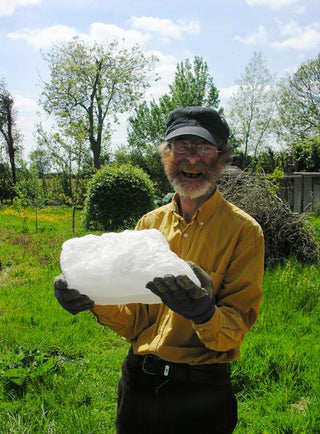Volcanic Alum Crystal, its History and Many Uses Natural Potassium Alum
Very few natural resources have enjoyed such a long history of international demand as alum crystal. Natural alum crystal is formed next to volcanic fumaroles. Being water soluble, natural alum was originally obtained from desert sources. In the seventeenth century, alum began to be manufactured from impure alum shale which is found in Britain. Due to its unusual properties, alum has long been one of the most valued medicinal, personal, craft and industrial resources.
Prehistoric uses
The key medicinal properties of alum are astringent, antiseptic, antimicrobial and it is strongly deodorizing. We can imagine, in the dawn of time, that hunter-gatherers walking over sun baked alum deposits would have experienced its deodorizing and healing effects. When used appropriately, the analgesic effect of alum is pronounced and wounds are sterilized and drawn closed by the astringent action. Alum also possesses antifungal properties.
Historical uses of alum
The earliest use of alum is first known from linguistic studies in Mesopotamia where it was used as a mordant for madder dye. Alum use does not seem to begin in Egypt until the end of the eighteenth and twenty-first dynasty (approx 1500 BC to 1000 BC) also for dyeing. Herodotus, writing in the fifth century BC, informs us that the Egyptians were using alum as an agent for mummification - presumably to deodorize the corpse! Reenactors needn’t to go this far with their experiments! It is more difficult to envisage how alum came to be used in many craft and industrial processes. Yet, the third century Stockholm and Leiden Papyri tells us how to use alum to make (fake) silver, pearls and applications for precious crystals, as well as how to dye textiles. Changing the appearance of base metals was clearly considered analogous to dyeing cloth. Generally artisans must have been very well versed at the subtleties of alum use. In fact these papyri may well have been ‘tawed’ or hardened and protected from fire and mould with alum. Pliny the Elder, the Roman historian (d.79 CE), had described some of the uses for different types alum in Chapter 52 in his 35th book of his Natural History and various applications: wool dyeing, leather tawing, leather tanning, for creating special metal and glass finishes, for medicinal and cosmetic uses. According to Pliny, alum, ‘… has the effect, also, of checking and dispersing perspiration, and of neutralizing offensive odours of the arm-pits.’
An Ancient deodorant
Pliny was very certain about the deodorizing properties of naturally formed pure alum (potassium alum) writing how it was used under the arm pits ‘to neutralize offensive odours.’ Cleanliness, to the Romans, was one of the hallmarks of civilization. In fact the volcanic alum is very effective as a deodorant. It kind to sensitive skin, it doesn’t stain costumes, it is portable, authentic for all periods and it is economical to use. Many reenactors can vouch for the deodorizing effects of the pure potassium alum, even after combat on the battlefield or after working at the forge.
Early medicinal uses
Pliny goes into detail with the medicinal uses of different types of alum, giving thirty eight remedies, many of which came to be used in this country until recently. His examples include the mixing of potassium alum and honey for mouth ulcers, pimples, pruriginous eruptions and putrid ulcers, and using alum infused in water to destroy lice and parasites. He refers also to calcined alum, alum which has been ‘boiled’ or bubbled on a heated tile, in this case with vinegar, then mixed with cabbage juice for leprosy. The boiling drives the water off the alum and turns it from granules into a fine powder. Despite Pliny’s encyclopaedic knowledge, he was not a naturopath and in reality, remedies using alum in later medical texts include many other herbal, mineral or animal derived ingredients and complex preparation methods ‘according to the art.’ Pure alum surely came into our rainy country for the first time with the Romans, firstly as medicine and secondly for deodorizing. It is unlikely to have been imported for industrial use at this point. Later, in the Medieval period, when foreign sources were regularly imported, much began to be written about alum in the country, especially by apothecaries. Hence alum appears in every major medical manual. Knowledge of alum came from Greco-Roman texts as well as via Arabic texts suchas the Cannon of Medicine by Avicenna and through the School of Salerno. We can not forget the movement of pilgrims, the clergy and fighting men in bringing knowledge and demand for alum to this country.
One of the key spokeswomen at Salerno, known as Trotula wrote in the eleventh or twelfth century not only on the medicinal uses of alum – obstetrics in this case but the author even included a recipe for revirgination using alum – a hint not lost among nineteenth century French prostitutes. Trotula also branched into the cosmetic virtues of alum. Again it is used for dental care and Trotula suggests the use of alum for lighting blemishes of the skin and in hair dyeing.
An alum dyeing recipe
As demand and availability grew, textile workers turned to alum as a mordant to fix otherwise ephemeral vegetable colours. From the 12th century, alum was established as vital to our growing wool dyeing industry. At this time, alum could not be manufactured from alum shale, so British dyers were completely dependant on importing naturally formed alum (potassium alum). For textile dyers some of the earliest alum recipes are recorded in the Stockholm Papyrus of the third or early fourth century, and such recipes continue with minor variations until our time. Alum was used not only as a mordant when dyeing textiles, wood and bone, alum was used to precipitate some pigments. In the papyrus, the mordanting process is explained in several ways. Here is an extract from Book 3 of Africanus, taken from the Papyrus. ‘Mordanting for any color is done in the following way. First the animal, or else likewise only the wool is washed; then one can allow the mordanting agent upon it. One should then dissolve alum in vinegar and coat the wool, which one desired to dye, with it. After drying in the sun it is washed, and when it is freed from its moisture admit it to any coloring. One must pay attention to that which is mordanted for a day and a night during the mordanting.’ Note the option between mordanting the wool while it is still on the sheep, or waiting until after is has been shorn! Perhaps you could dye a sheep on the hoof too. The Papyrus gives other methods of using alum for dyeing specific colours such as quince yellow, leek green, rose, madder purple, scarlet red.
Importing alum
Abundant where it occurs, but being water soluble, alum is absent in its pure crystal form in wet climates such as Britain and Northern Europe. Old World sources of pure alum are North Africa, countries fringing the Mediterranean, the Aegean, Anatolia, the Black Sea, Asia Minor and as far afield as Lake Chad. It is found much further afield in India and China too. Cargos of natural alum loaded on carracks from Genoa, and on occasions Venetian galleys, as well as other ships from Spain and Portugal docked at Bristol, Southampton and London. Alum supplies were transported further north through the activity of the Burgundian and Hansa merchants from the East coast of Britain and westwards to Ireland. From the twelfth century alum was being sourced from Egypt. After the Fall of Acre in 1215 CE, alum sources switched to the Near East and Anatolia. At the same time Italian and Portuguese merchants imported both alum and gold from ports from the Maghreb including Cueta and Tangiers. The importance of the North African link grew through the Elizabethan era due to the increased demand for imports of gold also obtained in Africa. In 1436 a process was applied to rock bound alum in Tolfa, Italy, transforming alum containing rock into industrially produced alum, ammonium alum. Desiring to raise funds from alum sales for another Crusade, Pope Pius II claimed a monopoly on the alum market. Not every European country supported the Papal campaign, even with threats of excommunication. Pope Pius II could not have known that the Reformation was just around the corner and that many other countries would eventually learn his secret process as well. The Genoese maintained their grip over the alum trade as supplies of natural alum more difficult to obtain they began to export the cheaper alum began to be manufactured at Tolfa in Italy.
Alum Piracy
As a result of a refusal of our country under Henry VII to support the Papal alum project, there began to be alum shortages in this country. During the fifteenth century attempts were made in Ireland, Cornwall, the Isle of Wight and in Dorset to create industrial alum, all ending in failure. As expected, the Papal boycott was continued by Henry VIII and Elizabeth. Due to the shortage, British privateers began to seize ships of Papal alum and divert them to England. In a letter (1529 CE) to Cardinal Wolsey, Sir John Daunce explained that he had seized a ship of alum, whose cargo was secured in a house in London. Sir John felt he could not explain the matter to the Cardinal in person, because, ‘I can not show my face, having been shaved by a barber with an unclean razor.’ Ironically if Sir John’s barber had used an alum crystal as a shaving styptic, it would have sealed the shaving cuts quickly and taken away any shaving rash. Of course a good razor and the right shaving soap would have prevented the embarrassment in the first place.
Industrial Ammonium Alum Production
Still the Tolfa works dominated production and the complex process remained a secret. Around 1600 interested naturalist, Sir Thomas Chaloner observed the similarities between the plants growing around the Tolfa works and also the geology to those on his own estate. He set out to learn the secret of alum production and to start works at home. Not able to not gain entry to view the whole process, Chaloner resolved to abscond with two key Tolfa workers. He sailed away with them reputedly hidden in barrels. They worked together at Belman Bank, Guisborough and helped to establish the alum industry there. Only in the 1607 was a reliable method developed in Britain, enabling the extraction of native alum from alum shale and Whitby in Yorkshire became a centre of production. Alum shale, wood, coal, seaweed and human urine were essential to the process. The poor as far away as London were paid for their urine, which was shipped in barrels to the alum works – the selfsame barrels which were loaded with ammonium alum for distribution. The industrial alum manufacturing method was granted a patent and a monopoly. In the same year further imports of alum were banned and so the pressure was on, especially as the output did not reach expected levels. Finally in 1635, the Yorkshire facility finally met the demand of some 1800 tones per annum. While these manifold crises unfolded, exactly how any shortfalls were met is our unwritten and unknown history, but piracy and smuggling must played a significant role. Following the Papal precedent at Tolfa, once the production was seen as profitable, a monopoly of British alum was granted to the Crown in 1613. With two years of low profits, the rights were returned to patentees, only to be taken back again by the Crown in 1647. In 1648, the monopoly was abolished, allowing the development of new alum works along the Yorkshire coast and the crown relinquished all its rights in 1679. The last British alum facility at Sandsend closed in 1871. The method for turning alum shale into alum was the precursor for the different industrial methods used today to create ammonium alum from waste from nylon and aluminium factories. The process with the smoking of alum stacks for 5 months or so was highly polluting and for good or worse, it spelt the advent of the Industrial Age. A highly polluting industry, some 100 tonnes of alum shale yielded but 1 tonne of alum. The ammonia based industrial alum is frequently confused with the volcanic potassium alum. Volcanic crystal alum is easy to recognise as each crystal is different and it can not be moulded into a regular and smooth shape. For cosmetic, medicinal, historical uses, the pure volcanic alum is authentic for most periods, performs far more effectively as a deodorant and it is free of industrial contaminants.
More recent British medicinal uses
Alum continued to appear in British medical manuals until recently and the use of alum was part of everyday knowledge. Recently, I met a midwife who used to work at Kelling Hospital in North Norfolk – she explained how she used powdered alum on the navels of newborns to help the umbilicus dry and stay infection free. While doing our rounds we met an Austrian opera singer who used alum as a compress to sooth the strained larynx. Many older customers have informed me how alum was used on canker of the mouth, in toothpaste to strengthen the gums; on cold sores as well as on athlete’s foot. Of course traditional barbers wielded large blocks of alum styptic to seal shaving cuts and to calm shaving rash. Alum does sting for some time on open wounds - Experimental archaeologists are advised to save alum for minor wounds. Home remedies used in Britain through the Modern period follow Pliny’s recommendations for gargling and mouth washing for gum and throat infections, loose teeth, on pimples, animal and plant scratches as well as on more serious injuries. I would not recommend using alum in the mouth. I have tried gargling with alum – just once! It has an unpleasant and lingering citrus-salty taste, impairing the enjoyment of food and drink for a whole day. Drinking water is purified with ammonium alum, but the water boards use very small quantities! The alum acts as a flocculent, drawing impurities together, allowing them to either sink or float so that they can be separated from the water. Alum leaves the water clear and sparkling.
Alum insect bite relief
Many people are familiar with using alum crystal to relieve the recent bites of ants, fleas, gnats, mosquitoes, horsefly etc. Using saliva as a wetting agent, the bite is rubbed with the crystal for a minute or so, starting on the outside of the bite and worked inwards. We have received lots of feedback on the cooling effect, lack of itching, swelling and faster healing time.
There is a use for alum which even I won’t be trying. The final glorious entry in a Welsh medical manual, The Physicians of Middfai, published in 1177 CE prescribes a mixture of alum, marsh mallow and egg white so that, ‘…a man might hold a red hot bar of iron without burning.’ Alum does have fire retardant properties. It might have still felt hot, but least we can be assured that the hand wouldn’t have caught alight. Alum was used to fireproof paper, wood and cloth and it is used in fire extinguishers. I can personally recommend alum for sterilizing and sealing a knuckle wounds. These wounds normally keep breaking open, deepening and enlarging. While at Wrest Park April 2012, I ripped my knuckle on a metal cooker grill. Having only just set up the tent at dusk in the hail and without clean water, I spat on the wound and sterilized it for a good few minutes with the piece of alum I carry around with me. I forgot about it until the next morning and then went to wash my hands. A thin flexible scab had formed. Despite attending tent pegs and acres of wet canvas all weekend, the wound never broke open and within no time it healed. In compelling Medieval fashion, I might add: Probatem est! (It is proven). In Britain we have a long and sometimes intimate connection with alum and its usefulness should ne’re be forgotten.
References
Bostock, J, 1855, The Natural History, Pliny the Elder, Londy Taylor and Francis
The website is www.naturalspasupplies.co.uk or you can call on 0800 023 5008 0r 01379 588100







